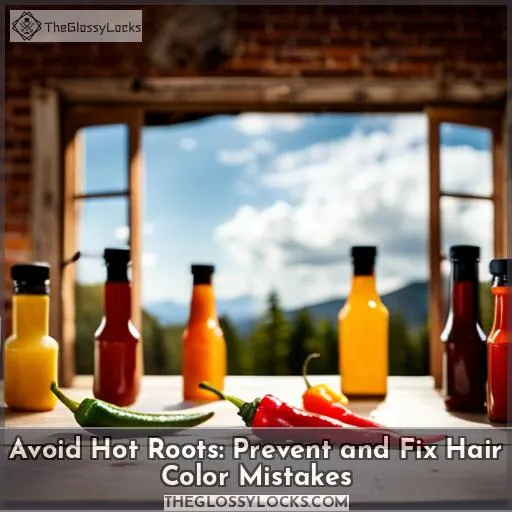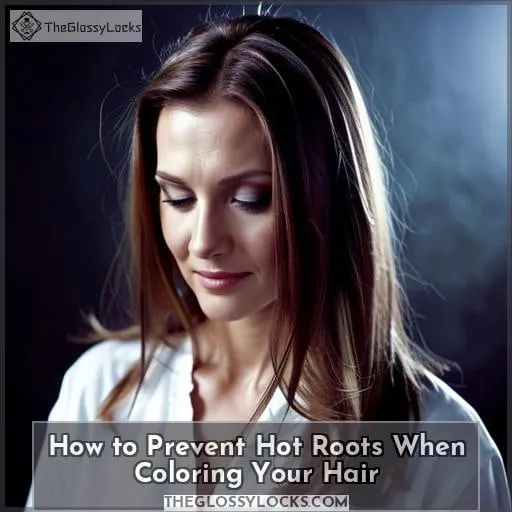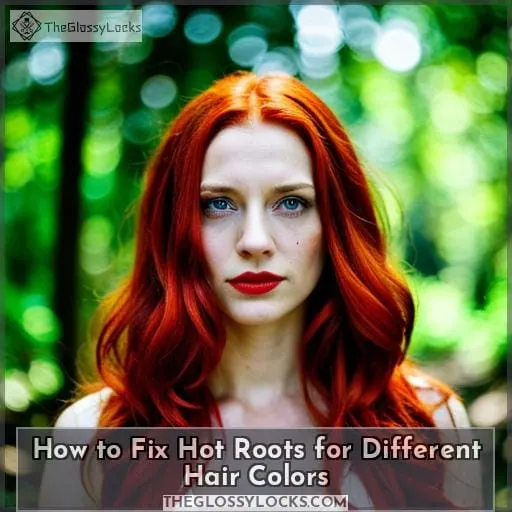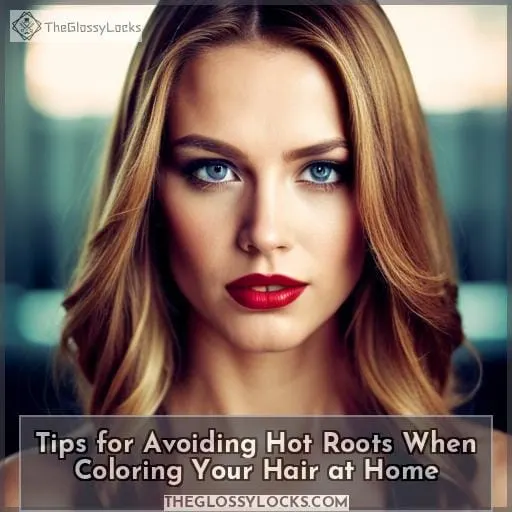This site is supported by our readers. We may earn a commission, at no cost to you, if you purchase through links.
 Are you tired of having hot roots and want to know how to prevent them? Hot roots occur when your hair’s regrowth is visibly warmer than the rest of your color, commonly resulting in an orange tone.
Are you tired of having hot roots and want to know how to prevent them? Hot roots occur when your hair’s regrowth is visibly warmer than the rest of your color, commonly resulting in an orange tone.
You can avoid this problem by choosing the right shade for your complexion, as well as using specific application techniques. We’ll also provide tips on fixing hot roots depending on different types of hair colors like blondes, brunettes, and redheads.
Don’t let hot roots keep you from achieving that perfect color; learn all about preventing it now!
Table Of Contents
Key Takeaways
- Hot roots can occur due to miscalculations in hair dye formulas or attempts to lighten colored hair.
- To prevent hot roots, it is important to stay within one or two shades of your current hair color.
- Fixing hot roots depends on the hair color – blondes can use beige or cool natural semi-toners, brunettes should add more brown to the root area, and redheads can try balayage or root adjustment formulas.
- Seek professional help from the Color Crew or a Hair Color Bar for hot root correction and maintain optimal color by addressing regrowth and texture changes.
What Are Hot Roots and Why Do They Happen?
Hot roots are an unwelcome and unnatural hair coloring result caused by miscalculations in permanent dye formulas or when attempting to lighten already-colored hair to a lighter shade. Body temperature can also have an effect on the processing of global colors, making hot roots more likely.
Causes of Hot Roots
Miscalculations in permanent hair dye formulas and the tendency to lighten pre-colored hair are among the common causes of hot roots. Poor color formulation, hairdresser mistakes, and body temperature can all lead to unwanted results such as this.
To avoid hot roots, it’s best to stick within one or two levels of your existing shade when coloring. If you want a lighter hue than what you currently have, try highlights or glosses instead for subtle changes over time.
For those already dealing with the hot roots issue, there are fix options depending on base colors. Blondes should use beige or cool natural semi-toners. Brunettes should paint more brown into their root area.
Redheads could opt for balayage freehanding techniques paired with toners at the regrowth line for contrast softening.
How Body Temperature Affects Hot Roots
The warmth of your body temperature can affect how the dye is processed when coloring globally, so it’s important to consider this before attempting a lighter color on treated hair. Hot roots prevention relies heavily on keeping an eye on root regrowth and processing that area faster than the rest of the head.
This helps prevent hot roots from forming due to heat buildup caused by bodily temperature affecting color uptake in previously colored strands. Root color techniques, such as freehand balayage and tint brush application, are key for successful correction if hot roots occur.
These techniques allow you to achieve smooth and blended results without over-processing any single section of hair or causing further damage with DIY lightening attempts.
Ultimately, monitoring body temperature throughout coloring sessions will help ensure consistent even results from root to ends!
How to Prevent Hot Roots When Coloring Your Hair
Ready to transform your hair color? Choosing the right shade and using the correct application techniques are key when trying to prevent hot roots. Utilizing tools such as an applicator bottle or a tint brush can help you achieve a harmonious hair color from root to end without any unwanted results.
Choosing the Right Shade
When coloring your hair, it’s important to choose the right shade for a flawless look that avoids hot roots. Consider selecting a regrowth color slightly cooler than the desired end result. You can also try root glow techniques such as balayage or ombre to give natural-looking dimension and coverage of grays.
When color correcting, make sure you understand the levels of your hair. This will help you avoid overcompensating with too dark of an application on top. Additionally, keep in mind that ginger roots can be harder to lighten without damaging them.
Here are some tips to keep in mind when choosing hair dye:
- Avoid drastic changes between colors.
- Aim for subtle transitions.
- Use products specifically designed for color correction.
- Consider using lighter shades around delicate areas like temples and crowns before adding contrast at the base and ends.
Application Techniques to Avoid Hot Roots
To prevent hot roots, make sure to use the correct application techniques for your coloring needs. Blending techniques like root application and color adjustment can help create a natural-looking color with no brass coverage.
Gradient coloring is also useful when you want to lighten hair evenly or tone away any undesired hues on the ends of your hair. For precision dyeing, try using applicator bottles or tint brushes that deliver more accurate results than hands-alone methods.
How to Fix Hot Roots for Different Hair Colors
Are you struggling with hot roots? If so, it may be time to get creative when fixing them. Blondes can drop their roots with a beige or cool natural semi-toner, brunettes should paint more brown on the root area, and for redheads, heavy freehand balayage or a root adjustment formula may do the trick.
Fixing Hot Roots for Blondes
Fix blonde hot roots with a beige or cool natural semi-toner for beautiful color harmony. To do this, use a toning technique to drop the root line and apply a root touch-up formula. For blondes, heavy freehand balayage is an option, as well as using ½ warm natural & ½ gold or auburn in the formula.
A hair color gloss can also add dimension and depth, while toners help soften the contrast between shades of blonde.
Fixing Hot Roots for Brunettes
For brunettes, painting more brown on the root area is an effective fix for hot roots. To add dimension to your look, consider using a heavy freehand balayage or root adjustment formula. This can give you up to five levels of lift and create stunning results! A corrective root booster helps neutralize brassy undertones while toning color-treated hair with a brown-based gold-red hue.
For further improvement in texture and shine, apply deep conditioning treatments at mid-lengths and ends before applying formula correction.
Fixing Hot Roots for Redheads
If you’re a redhead, getting rid of hot roots can be tricky – but don’t worry, there are solutions!
For a luxe root color that gradually covers the regrowth while blending seamlessly with existing hair color, try using Sheer Root Blush. This permanent hair color is created specifically for redheads and will give your locks an ash-toned hue to soften the contrast between lightened ends and darkening roots.
To further fix hot roots on natural or chemically-treated tresses, opt for heavy freehand balayage or a root adjustment formula consisting of both warm natural and gold/auburn shades.
Whatever option you choose, it’s important to tone afterwards with an ash toner in order to achieve a soft yet blended transition from mid-lengths down towards your scalp!
Tips for Avoiding Hot Roots When Coloring Your Hair at Home
When it comes to lightening your hair color at home, using a highlighting kit for subtle highlights can be a great way to avoid hot roots. With the right technique and tools, you can achieve beautiful results without having to worry about any unwanted coloring issues.
Lightening Your Hair Color at Home
When lightening your hair color at home, make sure to take extra caution and only go one or two levels lighter for the best results. DIY hair color can be tricky and may cause hot roots if done incorrectly. To avoid this, consider using a highlighting kit to add subtle highlights instead of significantly lightening the entire shade.
As you work through the process, use tools like an Applicator Bottle or Tint Brush for clean application throughout your whole head, rather than just focusing on the roots. It’s important to take note of your natural color range to prevent excessive warm brassy regrowth when lightening darker shades, especially if it’s a drastic change from your previous hair color.
To finish off any coloring job at home, use toners that are specifically designed for post-color correction. Madison Reed’s Color Reviving glosses collection offers great options for this purpose.
Using Highlighting Kits for Subtle Highlights
Try using a highlighting kit for subtle highlights to achieve the perfect color blend from roots to ends. DIY highlights offer great flexibility when it comes to hair lightening, allowing you to target specific areas instead of full head application.
Highlighting kits provide an effective solution for avoiding hot roots and achieving an even tone and shine throughout your hair. These kits come in various shades, so you can customize your look while still maintaining natural-looking results at home without risking any damage or dryness.
Seeking Professional Advice for Correcting Hot Roots
Are you struggling to correct hot roots? Seeking professional advice can help. Contact the Color Crew or visit a Madison Reed Hair Color Bar for personalized assistance on the frequency of retouches and a modern contemporary approach.
Contacting the Color Crew or Visiting a Hair Color Bar
For professional advice on correcting hot roots, contact the Color Crew or visit a Madison Reed Hair Color Bar. Get personalized color formulas, texture and volume products tailored to your hair type. With a Visa gift card in hand, browse through coloring conditioner options for that perfect shade.
The salon experts will make sure you’re taken care of while recommending top-notch services such as the Flip Application Routine and more! Discover why so many color lovers call us their go-to source for all things colorful – from hair to makeup!
Make an appointment today with our team of knowledgeable professionals who specialize in finding solutions for those tricky hot root issues!
Frequency of Retouches and Modern Contemporary Approach
To maintain optimal color, consider the frequency of retouches and use a modern contemporary approach for long roots and virgin tints. It’s like painting a masterpiece with precision. Hair color maintenance is essential to avoid hot roots or the need for root touch-ups.
Keeping up with regrowth is important to prevent an unnatural contrast between your current hair shade and the new growth.
The frequency of retouches depends on factors such as grayness, texture changes due to the environment or product use, and an individual’s natural hair growth rate. However, regular upkeep will guarantee beautiful locks without any unwanted hues.
Conclusion
Overcoming the fear of dealing with hot roots can be daunting, but with the right steps and techniques, you can achieve harmonious hair color. Whether you’re coloring your hair yourself or visiting a professional, knowing how to prevent and fix hot roots is key.
When selecting a shade, always choose one that’s the same level or darker than your existing color-treated hair. Use the right tools and techniques, such as an applicator bottle or tint brush, to ensure a clean application.
Remember to also lighten your hair color at home by one or two levels and use highlighting kits for subtle highlights.
If you’re still feeling unsure, contact the Color Crew or visit a Madison Reed Hair Color Bar for personalized advice on correcting hot roots.
By following these steps, you can avoid and fix the dreaded hot roots!








